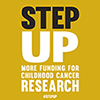Retinoblastoma is a rare cancer, occurring in about one in 20,000 children. It originates in a part of the eye called the retina, a thin layer of nerve tissue that coats the back of the eye, allowing a person to see. Retinoblasts (immature cells of the retina) multiply during gestation and early life to make enough cells to create the retina. As children age, the cells mature and are no longer able to divide and multiply, a process called differentiation.
About 300 children are diagnosed with retinoblastoma in the United States each year. The disease occurs most often in children under 4, and makes up nearly 3% of all cancers in children ages 0 to 14.
Scientists do not know what causes the immature retinoblasts to turn into cancer cells (a process called transformation), but do know that in order for retinoblastoma to develop, there must be a change or mutation in both copies (one from each parent) of a gene called RB1. In most children with retinoblastoma, this change occurs in only one cell, leading to a single tumor. the change occurs in more than one cell, and if more than one tumor is detected (in one or both eyes) it means that a change had already occurred in one copy of the gene before conception. What precisely triggers this change or mutation is not known. This leads to two very distinct disease types:
Genetic
The genetic form of retinoblastoma occurs in 40% of children diagnosed with the disease. These children are born with the change in one copy of the RB1 gene in every cell in the body, including the cells in the retina. If the second copy of the gene undergoes a change, a retinoblastoma tumor can develop. Since every cell has the first copy of RB1 mutated, it is relatively easy for more than one cell to undergo a change in the second copy.Most children with the genetic form do not have a parent with retinoblastoma, rather, the change in the gene occurred in either the egg or the sperm of one parent prior to conception. Even if the child has the genetic form, if neither parent has the tumor, the chance that retinoblastoma will occur in another child in the family is less than 1%. However, the risk of tumor in the offspring of a child with the genetic form of retinoblastoma is about 50%. Having the genetic form of the disease also increases a child’s risk of developing other cancers later in life.
Hallmarks of the genetic form include:- May have more than one tumor
- Tumor often affects both eyes
- May have tumors in other parts of the body
- At increased risk for other cancers later in life
Non Hereditary
Most children with retinoblastoma do not have the genetic form; they are not born with the RB1 gene mutated in every cell of the body. They develop tumor in only one eye (unilateral) because both RB1 genes in a single retinoblast (immature cell) has undergone the mutation. Scientists don’t know how or why this occurs. These children do not have an increased risk of developing other cancers, and their offspring have the same risk of developing retinoblastoma as other children in the population.Last updated July, 2011
Newly Diagnosed with Retinoblastoma
In Treatment for Retinoblastoma
After Treatment for Retinoblastoma








